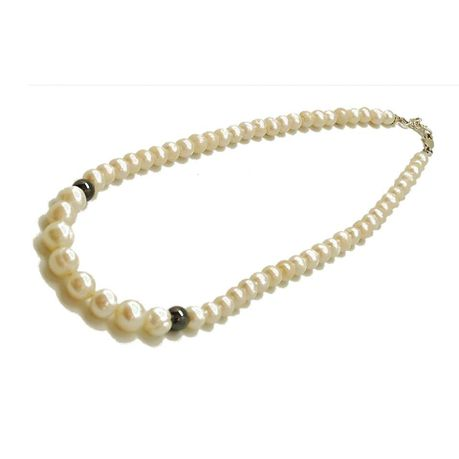
What is Pearl?
A pearl is a hard, glistening object produced within the soft tissue of a living shelled mollusk or another animal, such as fossil conulariids. Just like the shell of a mollusk, a pearl is composed of calcium carbonate in minute crystalline form, which has deposited in concentric layers
Pearl Prices In South Africa
White freshwater pearl necklace – 45cm

Because they’re so rare, natural pearl jewelry can fetch 10 to 20 times the amount of cultured pearls and is usually limited to auctions and exclusive collections. Natural pearls can range in price from around R500 right up to hundreds of thousands of rands for top-quality South Sea pearls, for instance.
How Are Pearl Prices Determined?
Because pearls come in such a vast array of shapes, sizes, and colors there is a multitude of things to consider when valuing any given pearl. Whether they are natural or cultured is one of the major considerations, but it is most certainly not the only one. A huge amount of knowledge and experience is needed to put a price on a pearl. This is why only experts are responsible for grading pearls!
Types of Pearls and Their Value
Pearls come in lots of different types, depending on what area they’re grown and by which oysters. Often, the type of pearl will play a large part in determining its value. This is one of the main reasons that certain pearl varieties are so sought-after. For instance, Tahitian pearls are considered one of the most valuable. Here are some of the most common types of pearls and their approximate values:
- South Sea Pearls
- Tahitian Pearls
- Akoya Pearls
- Freshwater Pearls
Size of Pearls and Cost
The size comes into play when determining pearl price, just as it does with other rare gems. Because pearls are grown inside a living organism, they take time to reach their full size. Size is also determined by the type of mollusk in which the pearl grows. Real pearls range in size from tiny ones of just 1mm to 20mm or bigger. South Sea pearls are often particularly big.
A good general rule is that the larger the pearl, the longer it has taken to grow. With all other factors being equal, a larger pearl is rarer and more expensive. Commonly, cultured pearls are between 6mm to 7.5mm. Above this, the price of the pearl rises quickly with each extra half a millimeter.
Pearl Surface Quality and Cost
The surface quality of a pearl is one of the biggest facets of its value. A smooth, bright pearl with a reflective surface is ideal. The more luster visible on the surface, the better! This will also add to the value of a pearl.
Naturally, these perfectly even and smooth pearls with luster are much harder to find than pearls with small imperfections like spots or abrasions, chips, or cracks. Lightly spotted pearls have small imperfections which a pearl expert would be able to pick up on, and are also highly valuable. Blemishes that can be seen with the naked eye will reduce the value of a pearl considerably.
Pearls that have obvious and severe spots and abrasions are also less likely to be durable, so their value decreases accordingly.
The Shape of Pearls and Their Value
Pearls come in four main shapes: round, semi-round, off-round, drop, and baroque. Round pearls are the most sought-after of all pearl shapes, and if all other factors are equal, will fetch a higher price than others.
Semi-round pearls are pearls that appear round to the naked eye but are not perfectly spherical when they are examined. They can represent good value for those who want the look of round pearls but don’t mind if they aren’t completely even. Baroque pearls are irregularly shaped and adored for their uniqueness. Drop pearls resemble a teardrop, and if they are completely symmetrical and classically shaped, can also command very high prices.
